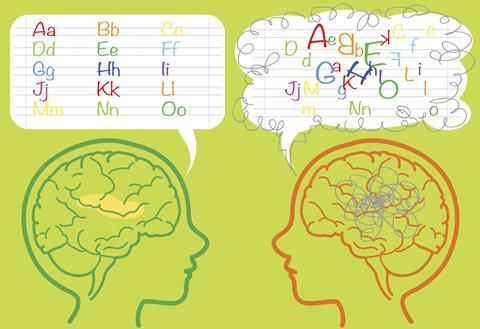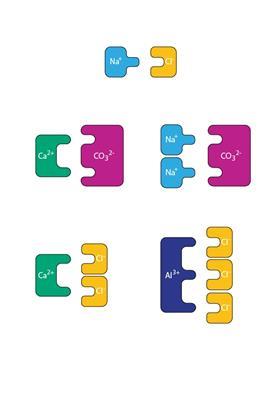Chemistry is really challenging – use these tips to make your lessons inclusive, engaging and memorable

What is dyslexia?
Dyslexia is a specific learning difficulty. People with dyslexia underperform in tasks involving reading, spelling and writing but can do well in other areas of learning. It affects up to 10% of the population to varying degrees and across the full range of intellectual ability.
Strengths
Dyslexics tend to be imaginative and creative. They tend to be good verbally and are often quick, visual thinkers who make unexpected lateral connections. They also tend to be intuitive and often impulsive, relying on gut-feeling rather than logical sequential processing. They can be sensitive to the needs of others and so can work particularly well in groups.
Difficulties
Dyslexic students have difficulty interpreting the written word. They read slowly and inaccurately. Their spelling may be phonetic and erratic and they may not be able to process information at the same time as writing or reading. Numbers or letters may be reversed in their work, eg 35 for 53, or Ca for Co, substituting cobalt for calcium.
Mistakes increase under time pressure or with tiredness. Short term memory is often poor so rapid revision is difficult. Information has to be stored in long term memory by increased repetition or by devising quirky ways to link facts.
Organisation and time keeping may also be additional problems that hinder chemistry practical tasks and coursework.
Why is chemistry challenging?
Chemistry relies on logical thought, accuracy and an ability to understand abstract concepts. There is heavy use of letters, numbers and equations to represent chemicals and reactions, which have to balance. Small changes in word endings such as ‘ate’, ‘ite’, and ‘ide’ are important– these are all huge stumbling blocks for dyslexics. You can’t conjure up an equation by intuition, and inaccuracies easily occur.
In addition, some chemical symbols are confusing unless explained: Why is potassium represented by a K and sodium by Na? Learning bonding values is also difficult if it has to be done by rote.
A lack of basic understanding or high error rate can cause students to lose confidence and feel upset and depressed. Dyslexics are often sensitive to criticism and any implication they are ‘careless or lazy’ can be taken to heart and cause hurt. They may decide that they are useless at chemistry and develop ‘chemistry phobia’.
How can teachers help?
If chemistry is relevant to life and enjoyable, dyslexic students will engage enthusiastically and work hard to understand the theory. They are imaginative and innovative and can eventually become excellent research scientists. First, however, they must jump over the hurdles of the school years and supportive teachers can make all the difference.
Five simple ideas for inclusive chemistry lessons
Make lesson activities as visual and hands-on as you can – this will be much more memorable.
1. Use models where possible – the local toy or craft shop can provide balls or beads in different colours to represent atoms, molecules, elements and compounds. This applies also to post-16 work where popper beads make good polypeptide chains, a ‘slinky’ makes an excellent α helix and 3D structures can be modelled with children’s dough or pipe cleaners. Commercial model kits are also available.
2. Consider showing simple bonding using laminated coloured card jigsaw pieces to represent atoms that slot together. The number of holes or tabs corresponds to the charge number. Download a jigsaw piece template (pdf).
3. Colour the periodic table with two colours for metals and non-metals and then shade the elements with greater bonding values in darker shades of these colours.
4. Mnemonics help the memory, for example:
MALE MAP – metals always lose electrons, metals always positive
OIL RIG – oxidation is loss, reduction is gain
5. You or the students can invent quirky ways of remembering things. For example, for atomic structure:
- Protons Positive
- Electrons Negative
- Neutrons Neutral
Students can illustrate these and even give them cartoon characters.
Quick tips for supportive teaching
• Let the student know you understand their difficulties and will work with them to find solutions. Keep your comments upbeat and positive where possible.
• Set information into context, preferably relating to tangible, everyday examples. Dyslexics tend to prefer to understand the big picture before any detail.
• Reward progress, celebrate success and give encouragement.
Diagrams
• Show pictures as well as write names of apparatus when giving practical instructions.
• Label cupboards with words and pictures.
Worksheets
• Give out worksheets with gaps to fill in– do not expect students to copy down a lot of writing.
• Illustrate notes and leave white space in work sheets– avoid daunting walls of text and allow extra time for processing written information.
• Use a large clear font such as Arial, Calibri, or Trebuchet and avoid fancy lettering with serifs.
• Encourage students to highlight or underline key points.
• Give a glossary of key words and terms which the students can illustrate.
Variety
• Create opportunities for students can make up raps, songs, board games, word searches or podcasts to aid memory.
Diana Hudson is the author of Specific learning difficulties: What teachers need to know published by Jessica Kingsley. Diana has dyslexia and a PhD in zoology. She runs training courses for teachers. dianahudson@btconnect.com
Downloads
chemical bonding with charges jigsaw
PDF, Size 0.14 mb
Learning difficulties and chemistry

Use these tips to make your lessons inclusive, engaging and memorable
 Currently
reading
Currently
reading
How to support dyslexic students
- 2
- 3















No comments yet